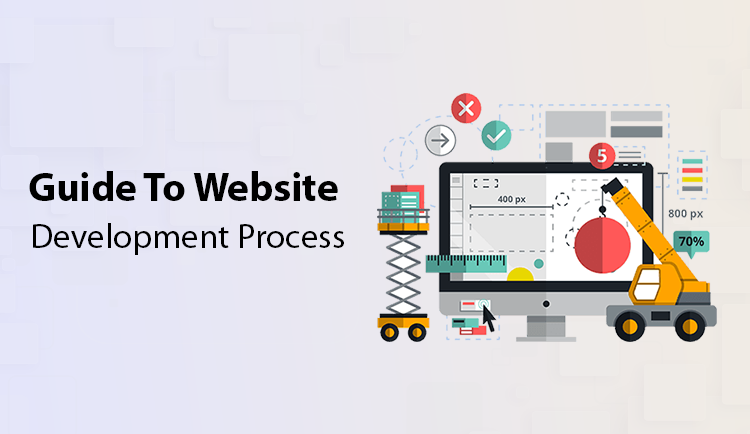
A Concise Guide To Website Development Process
Today, people utilize the internet for a wide variety of purposes, including shopping, conducting business, communicating with one another, learning new things, paying bills, and so on. And all of these have been made possible with the help of the website development process.
Companies worldwide are now conducting business online, and web development plays a crucial role in their success.
This article provides a concise overview of what the website creation process might entail. Overall, there are five to eight stages of development, but the big picture is consistent across all of them.
To begin, let’s define “Web Development.”
Image: Freepik
Web development is the process of creating and maintaining websites. Developers put in a lot of effort to make a site that is appealing, runs quickly and provides a pleasant experience for visitors.
Web developers, sometimes known as “devs,” implement several website development techniques, protocols and programming languages to come up with a site that STANDS OUT! The languages they employ change based on the nature of the work being done and the mediums they are utilizing.
Web development has evolved into a highly lucrative industry that is also in extremely high demand.
Different Types of Web Development Processes
The three most common approaches to creating a website are as follows:
1. Front-end Web Development
Front-end web development refers to the process of creating a website’s visual and interactive user interface in markup languages like HTML, CSS, and JavaScript.
The aesthetics of a website are the domain of front-end development. The visual style includes the use of color, font, icon, and picture.
The front end of a website needs to adapt to many screen sizes, from desktop computers to tablets and smartphones.
A front-end developer is a person who works on the visible part of a website or application, the part that people see and interact with.
2. Back-end Web Development
Back-end development refers to the process of creating the invisible parts of a website, or the server-side software, which includes back-end logic, APIs, architecture, and servers.
When it comes to websites, it is the back-end developers’ job to create and maintain the underlying code. This code establishes a connection between your site and the server, allowing for smooth data transfer and transaction processing.
Common languages include Java (not to be confused with JavaScript), PHP, MySQL, and Python.
3. Full-Stack Web Development
Full stack development encompasses end-to-end development of the application. Both front-end and back-end tasks are included in full-stack web development. Depending on the site’s complexity, a single developer may be responsible for both the backend and frontend, or “full-stack,” of development.
When it comes to improving a website’s commercial viability, full-stack developers are typically tasked with spotting emerging technologies like improved programming languages (or even no- or low-code trends) and blockchain.
Eight Stages Of Web Development Process
Here are the eight stages of Website Development Process; take a look:

Stage 1. Collecting Information
The first and foremost step in the website development process is to define Why, What, and Whom.
- WHY do you want to create a website?
- WHAT do you want to achieve from your website?
- WHOM do you want to serve via your website?
The shape of the succeeding stages is decided at this stage. You need to define its future functions, your primary objectives, and the type of visitors you hope to attract.
Know that every website is different and unique in its own way. For example, an eCommerce website development will differ from a website dedicated to sports and fitness equipment. In a nutshell, different websites offer different features to their viewers. Therefore, different technologies are used to create these websites.
Having clarity of your target audience, business goal, and web functionalities that you want can save time and money. Also, it will prevent the need to address unforeseen problems, such as modifications to the design or the addition of unanticipated features later on.
Stage 2. Wireframing
“Wireframe” is a visual outline of the final product. In this stage, the developer provides the information that gives a client an idea of what the final site will look like.
The purpose of wireframing in web development is to provide you and your developer(s) with a shared vision for the final product of your collaboration.
Wireframes can be used to determine the optimal placement of various elements, such as text and media, on specific web pages.
In this stage of website development, you can preview your content’s front-end presentation with the use of “dummy text.”
Stage 3: Site Mapping
The sitemap is developed on the basis of the data acquired in stage 1 of the web development process. Your site’s sitemap should outline the connections between its primary sections.
A sitemap provides the necessary information regarding your vision to your developer. You can construct your own sitemap or collaborate with a professional(s).
Here are some questions to consider when creating a website:
- How many landing pages do you need?
- What is the page hierarchy of your website?
- How will the pages be connected?
- What items will these pages contain?
- How can these pages be organized into categories?
It’s always good to discuss all these with your team or with the web development company that you have hired.
The choice of programming language, frameworks, and content management systems (CMS) is also made in this stage.
Stage 4: Designing, Reviewing, and Getting Approval for Page Layouts
All the photographs, photos, and videos will be produced at this stage of the web development process.
One or more designers may work on the site’s layout. Any form of visual representation, from rough sketches to finished designs, is included in this stage.
The logo and brand colors should be implemented into the design of the site in a way that is both strategic and aesthetically pleasing. Web designers often produce multiple prototypes (a static graphic depicting the ultimate design of the website).
Before beginning development on a website, it’s a good idea to provide the customer with a clickable prototype so they can get a feel of it.
At this stage, you’ll likely exchange emails and work with your clients through the document and media-sharing platforms.
The idea is to keep your client in the loop throughout the entire design and development process. Communication and group discussion are essential at this stage.
The client can then examine the design and provide comments. Accordingly, you can revise the layout and submit it back to the client if he has concerns about any part of your design.
It’s important to keep cycling through these steps until the client is entirely happy.
Stage 5: Content Creation
Content creation and compilation is one of the most important stages of the website development process. This stage often overlaps with other processes in website development.
Get down on paper what it is you want your website visitors to take away from their experience with you.
Making compelling headlines, adding calls to action, and producing compelling text is vital in the web development process. And all this takes time and effort.
Having all of a website’s content ready before or while it’s being coded is ideal.
Stage 6: Coding and Website Building
This is the point where developers begin working on the actual website. At this stage of the website development process, developers build an actual website using the graphic elements produced in earlier stages.
Typically, a site’s homepage is built first, followed by its interior pages, which are organized according to a sitemap outlining the site’s hierarchy.
Frameworks and CMS should be implemented to ensure a smooth installation and configuration process.
First of all, all mocked-up and laid-out static website components are built and tested. Then, interactive components and other special features are included.
Web developers must be accustomed to web development techniques in order to build a website that stands out.
Stage 7: Testing and Deployment
At this stage of the website development process, each link should be checked to ensure that there are no malfunctions.
Spell Checking software should be used on all forms and scripts to catch any spelling or grammar mistakes. In addition, code validators must be used to ensure that your code is up-to-date with web standards.
It is necessary to check each page to ensure that all of the website’s links are operational and that the site is shown accurately across a variety of browsers.
The website should be made public once the client has provided their final approval.
Stage 8: Maintenance & Upkeep
The last stage of the website development process is maintenance. Know that your website is the first impression that your clients will have about your business. Hence, it is crucial to maintain your website on a regular basis.
Companies that neglect their websites suffer significant drops in Google’s search engine rankings. Therefore, once your website is live, it is crucial to maintain it regularly.
New content and features can be subjected to user testing on an ongoing basis to enhance their usability and discoverability.
Installing a feedback system on the website can help you know about any issues experienced by visitors. Accordingly, you can repair those issues in a timely fashion and make your website rank high at all times.
If you don’t, you can find that consumers eventually abandon your site in favor of one that doesn’t force them to deal with unnecessary hassles.
Also, keeping your website up-to-date is crucial. You can use a content management system for that. Also, make sure you’re keeping it up-to-date on a regular basis to avoid security holes and problems.
Closing Thought
So, that’s all about the website development process. The stages of the web development process described above will help you build a unique website.
Keep in mind that the key to successful website development is maintaining a positive working connection with the client and communicating with them on a consistent basis. In addition, using the appropriate tools and web development techniques for the task at hand is always helpful.
Also, remembering that no part of a website’s growth is unimportant will help you avoid problems and give you confidence that things are moving along as planned and that you are in command.




